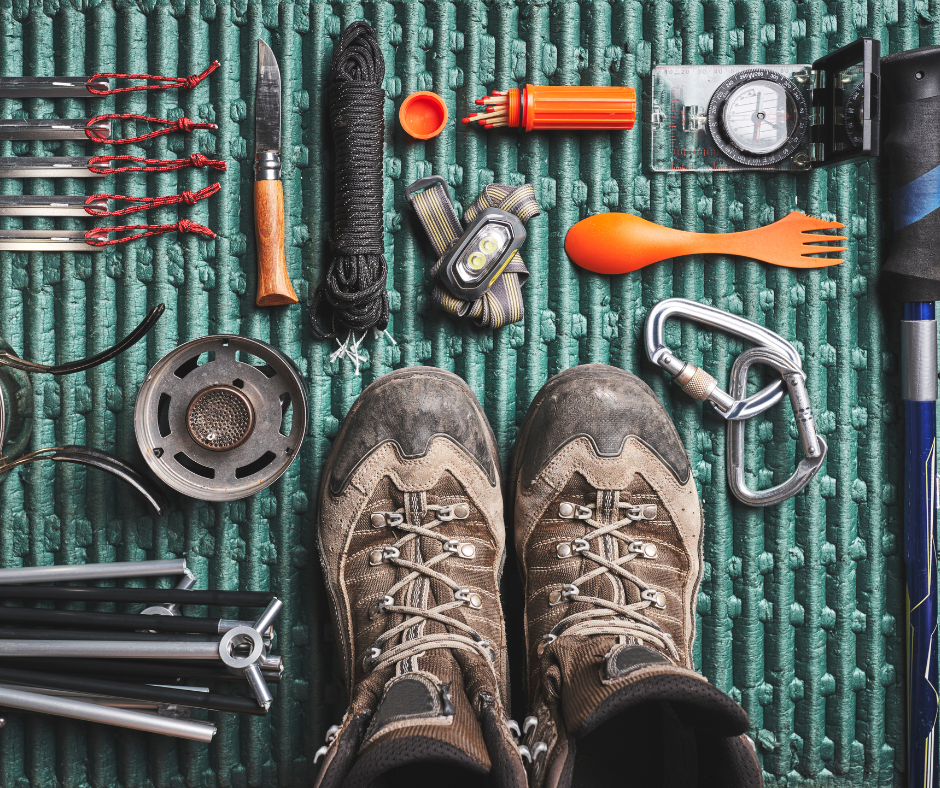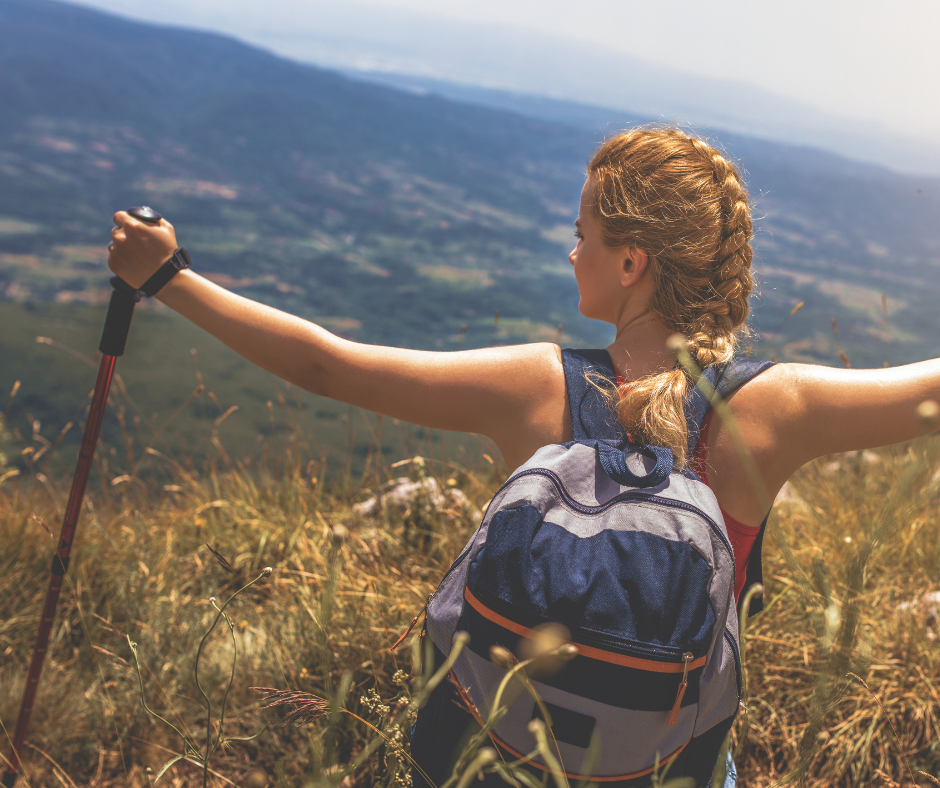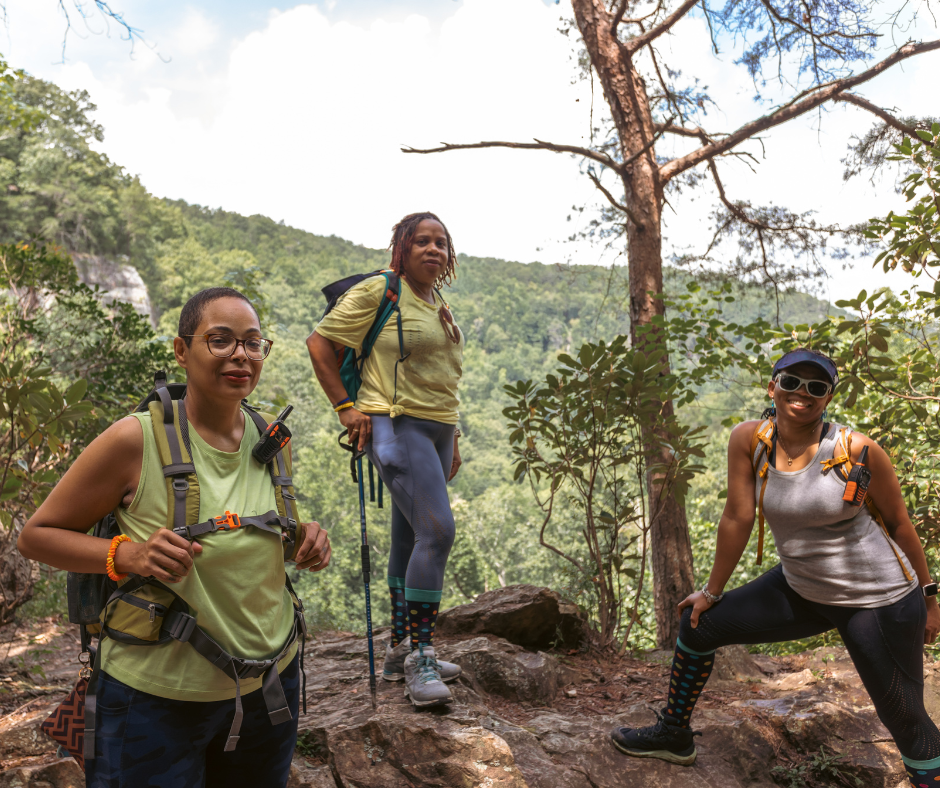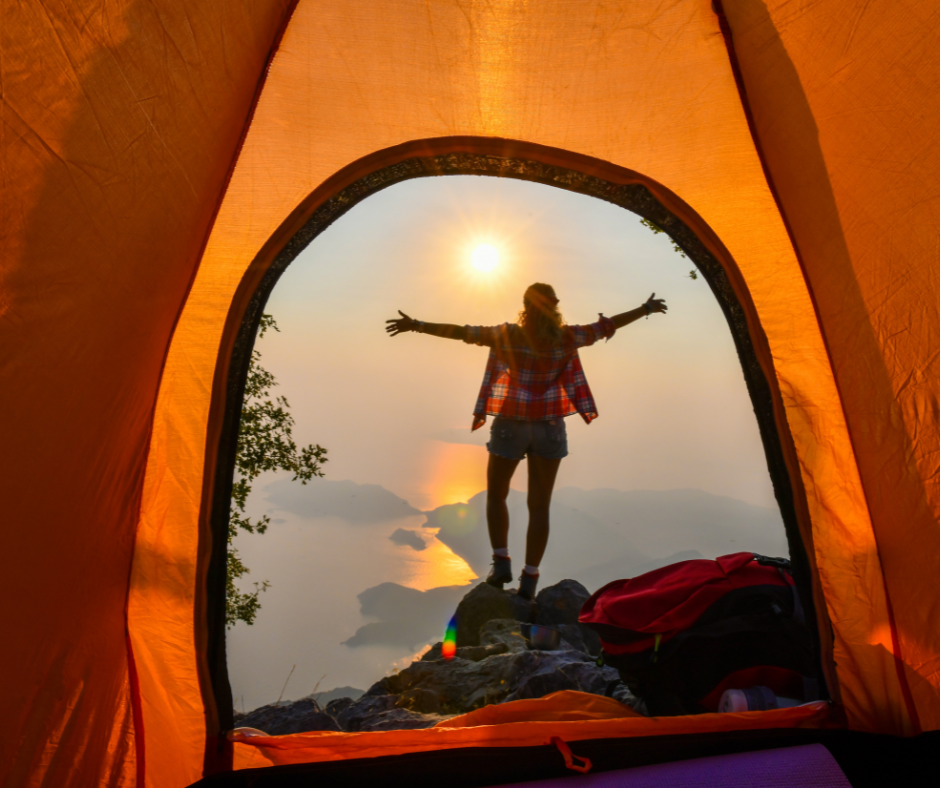

Going Solo? Follow These Camping and Hiking Safety Tips for Women
Summary
Reflection Questions
Journal Prompt
Taking a solo hiking or camping adventure can be an exhilarating and empowering experience for women. It offers a unique opportunity to connect with nature, find solitude, and challenge oneself. However, prioritizing safety is paramount to ensuring that these adventures remain enjoyable and trouble-free. By taking proactive measures and preparing adequately, women can confidently explore the great outdoors—balancing the thrill of adventure with the assurance of safety. Below are essential hiking safety tips to help you stay alert while savoring the beauty and tranquility of nature.
The Many Benefits of Spending Time in Nature


For women, the benefits of outdoor activities extend to specific health concerns. Physical activity in natural settings can help alleviate menstrual symptoms such as cramps and mood swings, thanks to the endorphins released during exercise. Weight-bearing exercises like hiking or running are particularly beneficial for bone health, helping to prevent osteoporosis, a condition more common in women, especially post-menopause.
Moreover, exposure to natural light helps regulate circadian rhythms and improve sleep quality, which in turn helps maintain hormonal balance, essential for overall well-being. Let’s take a closer look at all the benefits nature offers women.
Physical Health Benefits


Spending time outdoors offers a myriad of physical health benefits for women. Engaging in activities like hiking, biking, or walking can significantly enhance cardiovascular health by increasing heart rate and improving circulation. Regular outdoor exercise helps in maintaining a healthy body weight and reduces the risk of chronic diseases such as diabetes and hypertension.
Additionally, exposure to natural environments boosts the immune system. Phytoncides, airborne chemicals emitted by plants, have been found to increase natural killer cell activity, which plays a crucial role in fighting infections and diseases.
Mental Health Benefits


The mental health benefits of spending time outdoors are profound. Nature has a soothing effect on the mind, helping to reduce stress and anxiety levels. Studies have shown that being in natural settings lowers cortisol, the stress hormone, and enhances overall emotional well-being.
Sunlight exposure increases the production of serotonin, a neurotransmitter that helps regulate mood and happiness, alleviating symptoms of depression. Furthermore, spending time in nature improves cognitive functions such as attention, memory, and problem-solving skills, making it a great way to boost mental clarity and creativity.
Social and Emotional Benefits


Outdoor activities also offer significant social and emotional benefits. Participating in group activities like hiking clubs or outdoor yoga fosters social connections and builds a sense of community, which is vital for emotional health.
Achieving physical challenges in the outdoors, such as reaching a summit, can boost self-esteem and confidence, providing a sense of accomplishment and empowerment. Additionally, spending time in nature helps develop a deeper connection with the environment, fostering greater environmental stewardship and a sense of belonging to the natural world
20 Safety Tips to Help Women Avoid Potentially Dangerous Situations on the Trails


It’s essential for women to prioritize their health and safety alongside the thrill and fulfillment that nature offers. Embracing the wilderness can be an empowering and rejuvenating experience, but ensuring your well-being is paramount. By taking proactive measures such as thorough planning, carrying essential gear, and staying aware of your surroundings, you not only safeguard yourself but also enhance the overall enjoyment of your adventure.
Remember, the beauty of nature is best appreciated when you feel secure and confident in your environment. Balancing safety with the joy of exploration allows you to fully immerse yourself in the tranquility and wonder that the great outdoors provides. Below are our top twenty safety tips to ensure your next trip is both safe and fulfilling.
Research Your Destination


Choosing a well-traveled trail or campsite known for its safety is essential when hiking or camping alone. Start by reading reviews and researching online resources that provide information on the trail or campsite. Look for details about recent trail conditions, wildlife activity, and any alerts or advisories from local park services and emergency responders. Check the weather forecast. This research will help you prepare for the specific challenges of your chosen destination and ensure you are aware of any potential risks.
Inform Someone


Always inform a friend or family member of your plans before heading out. Provide them with your route, expected return time, and planned check-in times. This information is crucial because if something goes wrong, they can alert authorities and provide them with your last known location. Keeping someone in the loop increases your chances of being found quickly by rescue teams if an emergency occurs out there in the natural world.
Learn the Area
Familiarize yourself with the terrain, wildlife, and weather conditions of the area you will be visiting. Download offline maps and carry a physical map and compass to navigate accurately. Knowing what kind of predators might be in the area, such as mountain lions or bears, and how to react if you encounter one, is vital for your safety. Understanding the local environment helps you prepare better and respond appropriately to various situations.
Carry Essential (and Proper) Gear


Camping necessitates much more than well-fitting hiking boots, socks that wick moisture, and a sub zero sleeping bag. Bring essential gear that can make a significant difference in your safety and comfort.
A well-stocked first aid kit, multi-tool, flashlight, water filters, extra batteries, whistle, a bit of extra food, and fire-starting supplies are crucial. These items can help you handle minor injuries, navigate in the dark, stay hydrated, signal for help, and start a fire if needed. If you can accommodate it, consider bringing an extra day’s supply of food and extra clothing in case you find yourself in an unexpected situation.
Packing these essentials ensures you are prepared for various scenarios.
Pack Smart


Ensure you have enough food, water, and appropriate clothing for changing weather conditions. Pack lightweight, high-energy snacks, and enough water to stay hydrated. Wear moisture-wicking and layered clothing to adapt to different temperatures. Packing smartly means being prepared for unexpected weather changes and having enough resources to sustain yourself throughout your trip.
Add Self-defense Items to Your Pack
Consider carrying self-defense items like pepper spray or a personal alarm. These tools can provide an added layer of security and peace of mind. Know how to use them and keep them easily accessible in case you need to deter an attacker or signal for help. Being prepared with self-defense items can enhance your confidence while hiking or camping alone.
Stay on Marked Trails


Stick to marked trails to avoid getting lost or encountering dangerous terrain. Off-trail routes can be hazardous and increase the risk of injury or getting lost. Before setting out, read about the trail conditions to ensure your target trails have not been closed or experienced recent damage. Staying on marked trails helps you stay oriented and reduces the risk of accidents.
Fuel your creative fire & be a part of a supportive community that values how you love to live.
subscribe to our newsletter
Stay Aware
Pay constant attention to your surroundings and trust your instincts. If something feels off, don’t hesitate to move to a safer location. Staying aware includes listening for unusual sounds, watching for wildlife, and being mindful of the terrain. This heightened awareness helps you avoid potential dangers and react quickly to any signs of trouble.
Use Trekking or Hiking Poles


Trekking poles can significantly improve your stability on uneven terrain and reduce the risk of falls. In addition to setting you up for a more enjoyable hike, they also come in handy as a defensive tool if needed. Trekking poles distribute weight more evenly and help you maintain balance, making your hike safer and more comfortable. They are especially useful when traversing steep or rocky paths.
Choose a Safe Campsite


Select a campsite in designated areas where other campers are present. Avoid secluded spots that can make you more vulnerable to wildlife or unwanted human encounters. Being near others can provide a sense of security and assistance if needed. Setting up in a safe location ensures you are less isolated and more likely to get help if required.
Secure Your Food
Store your food in bear-proof containers or hang it from a tree to prevent attracting wildlife. Proper food storage is crucial to avoid encounters with animals looking for an easy meal. Following guidelines for securing food helps protect both you and the wildlife, reducing the risk of dangerous encounters.
Light Up the Night


Keep your campsite well-lit with lanterns or headlamps to deter animals and unwanted visitors. Some solo female campers also leave men’s clothing or boots outside their tent to create the illusion of not being alone. A well-lit campsite can prevent accidents and make you feel more secure at night. This practice can also help you see any approaching dangers.
Use a GPS Device
Carry a GPS device or a personal locator beacon (PLB) to ensure you can signal for help if needed. These devices are essential in areas with no cell service, providing a reliable way to communicate your location in an emergency. Having a GPS device increases your safety by enabling rescuers to find you quickly.
Emergency Numbers
Know the local emergency numbers and the nearest location where you can get help. Familiarize yourself with the contact information for local authorities and park services. Having this information readily available ensures you can act quickly in an emergency, increasing your chances of getting timely assistance.
Stay Fit to Hike Smart


Ensure you are physically prepared for the hike or camping trip. Regular exercise and conditioning help you handle the physical demands of hiking and camping. Start with shorter trips to build your stamina and confidence. Being physically fit enhances your ability to enjoy the experience and respond effectively to challenges.
Stay Calm
In case of an emergency, stay calm and think through your options logically. Panic can lead to poor decisions and increased risk. Take deep breaths, assess the situation, and consider the best course of action. Staying calm helps you make better decisions and manage emergencies more effectively.
Be Cautious with Strangers


Trust your gut feeling when interacting with other hikers or campers. Share minimal information about your plans to protect your privacy and safety. While most people you meet on the trail are friendly, it’s important to remain cautious and avoid revealing too much personal information.
Group Up Temporarily


If you feel uneasy, consider joining a group for a part of your hike. Temporary companionship can provide added safety and make you feel more secure. Grouping up can also enhance your hiking experience by allowing you to share the journey with others.
Learn to Identify Signs of Exhaustion, Dehydration, Heat Stroke, and Venomous Bites
Educate yourself on the symptoms of heat exhaustion, dehydration, and venomous bites. All can be extremely dangerous. Recognizing these signs early can prevent serious health issues. Learn the first aid steps for each condition, including how to cool down someone with heat stroke, rehydrate a dehydrated person, and treat venomous bites. This knowledge is crucial for maintaining your health and safety during your outdoor adventure. Also develop an emergency plan in case you are injured.
Know (and Respect) Your Limits


Understand and respect your physical and mental limits. Don’t push yourself too hard or take unnecessary risks to reach a specific destination. Listen to your body and take breaks as needed. Overexertion can lead to injuries and make it difficult to think clearly, increasing the risk of accidents. By knowing your limits and planning your activities accordingly, you can ensure a safer and more enjoyable solo adventure.
Final Thoughts: Making the Great Outdoors Safer for All of Us


Spending time in nature offers so many benefits for both men and women, but many women are worried about adventuring outdoors alone. Citing a global 2023 report from Strava in an article for GearJunkie, Michelle De Leon writes that women “’were 9% more likely than men to cite a lack of safe places to exercise.’” In the United States, those stats are even more concerning. Here, De Leon notes that “70% of women surveyed in the report don’t feel like they have a safe space outside.” Below are a few ways in which we can collaborate to make nature safer for women.
Improving Visibility


To make the outdoors safer for women, a multifaceted approach is required, addressing both infrastructure and community aspects. One effective strategy is enhancing the visibility and presence of law enforcement or park rangers in popular outdoor areas. This increased presence can deter potential threats and provide immediate assistance in case of emergencies. Additionally, well-lit trails and campsites, along with clearly marked paths, can significantly reduce the risk of accidents and make these areas less attractive to those with malicious intent.
Leveraging Technology
Technology also plays a vital role in enhancing safety. Personal locator beacons (PLBs), GPS devices, and smartphone apps designed for hikers can help women stay connected and track their locations. These devices can be lifesavers in emergencies, enabling quick communication with rescue services. Additionally, social media and dedicated apps can be used to share real-time updates on trail conditions and potential hazards, creating a network of informed and vigilant outdoor enthusiasts.
Community Engagement and Education


Another crucial aspect is community engagement and education. Encouraging outdoor groups and clubs to adopt a buddy system can help ensure women are never alone in potentially vulnerable situations. Educational programs aimed at teaching self-defense, first aid, and wilderness survival skills can empower women to handle unexpected situations confidently. Online platforms and local organizations can facilitate these educational initiatives, providing resources and support for women who love the outdoors.
Infrastructure Improvements
Investing in infrastructure improvements is essential for long-term safety. This includes maintaining and upgrading trail signage, ensuring that emergency call stations are functional, and providing accessible restrooms and shelters along popular trails. Partnerships between government agencies, non-profits, and private organizations can help fund these improvements, ensuring that outdoor spaces are safe and welcoming for everyone.








